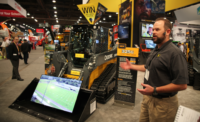Tweel Inventor Sees an End to Flat Tires on Skid Steers

When Tim Rhyne sat down with fellow Michelin engineer Steve Cron over lunch in the late 1990s, they didn't set out to reinvent the wheel. Tasked with defining the qualities of a pneumatic tire, the engineers sketched out a radial tire that didn't require any air. The result was the Tweel—a mash-up of "tire" and "wheel"—which mimics the performance of a radial tire using a circular shear beam and flexible spokes.
 |
| RHYNE |
"It was a eureka moment over lunch," says Rhyne, now a senior research fellow with Michelin Tweel Technologies (MTT). Unlike a solid wheel with rigid spokes, the Tweel maintains ground contact pressure like an air-filled tire. "The beam deforms almost entirely in shear, no bending," says Rhyne. "It maintains contact pressure, and the spokes determine stiffness."
Construction wasn't the first target market for the Tweel. In 2005, the Tweel first showed up on an Audi and Segway-type vehicles, says Jack Olney, business segment manager at MTT. "We developed a Tweel with NASA for a lunar rover, but it hasn't been used yet," he says. Because Tweel can have issues with vehicles engineered around pneumatic tires, "we needed situations where a Tweel could be bolted on and bring the user value right away," Olney adds.
Skid-steer loaders are a bit notorious for flat tires. Driven over all sorts of jobsite conditions, a heavily used skid-steer can blow through several tires a month. Some owners get fed up and fill their tires with foam or switch to solid tires, which eliminates flats but loses the handling benefits of pneumatic tires. At that point, the Tweel can be an attractive option.
So, what's next for the Tweel? "We're looking at other small, off-road equipment," says Tim Fulton, vice president at MTT. "We're not looking at larger equipment right now, but the Tweel is physically scalable, so, over the next year or two, we might be ready to talk about other equipment."






